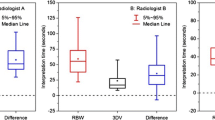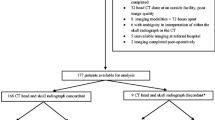Abstract
Skull fractures are common in the pediatric population following head trauma and are estimated to occur post head trauma in 11% of children younger than 2 years. A skull fracture indicates potential underlying intracranial injury and might also help explain the mechanism of injury. Multiple primary and accessory sutures complicate the identification of non-depressed fractures in children younger than 2 years. Detection of linear skull fractures can be difficult on two-dimensional (2-D) CT and can be missed, particularly when the fracture is along the plane of image reconstruction. Knowledge of primary and accessory sutures as well as normal anatomical variants is of paramount importance in identifying pediatric skull fractures with a greater degree of confidence. Acute fractures appear as lucent cortical defects that do not have sclerotic borders, in contrast to sutures, which might demonstrate sclerotic margins. Three-dimensional (3-D) CT has increased sensitivity and specificity for detecting skull fractures and is essential in the evaluation of pediatric head CTs for distinguishing subtle fractures from sutural variants, especially in the setting of trauma. In this review, we present our experience of the use of 3-D reformats in head CT and its implications on the interpretation, especially in the setting of accidental or abusive head trauma.


















Similar content being viewed by others
References
Orman G, Wagner MW, Seeburg D et al (2015) Pediatric skull fracture diagnosis: should 3D CT reconstructions be added as routine imaging? J Neurosurg Pediatr 16:426–431
Sim SY, Kim HG, Yoon SH et al (2017) Reappraisal of pediatric diastatic skull fractures in the 3-dimensional CT era: clinical characteristics and comparison of diagnostic accuracy of simple skull X-ray, 2-dimensional CT, and 3-dimensional CT. World Neurosurg 108:399–406
O’Brien WT, Caré MM, Leach JL (2018) Pediatric emergencies: imaging of pediatric head trauma. Semin Ultrasound CT MRI 39:495–514
Hsieh KL-C, Zimmerman RA, Kao HW, Chen C-Y (2015) Revisiting neuroimaging of abusive head trauma in infants and young children. AJR Am J Roentgenol 204:944–952
Parisi MT, Wiester RT, Done SL et al (2015) Three-dimensional computed tomography skull reconstructions as an aid to child abuse evaluations. Pediatr Emerg Care 31:779–786
Choudhary AK, Jha B, Boal DK, Dias M (2010) Occipital sutures and its variations: the value of 3D-CT and how to differentiate it from fractures using 3D-CT? [sic] Surg Radiol Anat 32:807–816
Idriz S, Patel JH, Renani SA et al (2015) CT of normal developmental and variant anatomy of the pediatric skull: distinguishing trauma from normality. Radiographics 35:1585–1601
Marti B, Sirinelli D, Maurin L, Carpentier E (2013) Wormian bones in a general paediatric population. Diagn Interv Imaging 94:428–432
Shoja MM, Ramdhan R, Jensen CJ et al (2018) Embryology of the craniocervical junction and posterior cranial fossa, part I: development of the upper vertebrae and skull. Clin Anat 31:466–487
Sanchez T, Stewart D, Walvick M, Swischuk L (2010) Skull fracture vs. accessory sutures: how can we tell the difference? Emerg Radiol 17:413–418
Zacharia TT, Nguyen DTD (2010) Subtle pathology detection with multidetector row coronal and sagittal CT reformations in acute head trauma. Emerg Radiol 17:97–102
Wei SC, Ulmer S, Lev MH et al (2010) Value of coronal reformations in the CT evaluation of acute head trauma. AJNR Am J Neuroradiol 31:334–339
Kleinman PK, Spevak MR (1992) Soft tissue swelling and acute skull fractures. J Pediatr 121:737–739
Erlichman DB, Blumfield E, Rajpathak S, Weiss A (2010) Association between linear skull fractures and intracranial hemorrhage in children with minor head trauma. Pediatr Radiol 40:1375–1379
Choudhary AK, Servaes S, Slovis TL et al (2018) Consensus statement on abusive head trauma in infants and young children. Pediatr Radiol 48:1048–1065
Kemp AM, Dunstan F, Harrison S et al (2008) Patterns of skeletal fractures in child abuse: systematic review. BMJ 337:859–862
Kelly P, John S, Vincent AL et al (2015) Abusive head trauma and accidental head injury: a 20-year comparative study of referrals to a hospital child protection team. Arch Dis Child 100:1123–1130
Bradford R, Choudhary AK, Dias MS (2013) Serial neuroimaging in infants with abusive head trauma: timing abusive injuries. J Neurosurg Pediatr 12:110–119
Martin A, Paddock M, Johns CS et al (2020) Avoiding skull radiographs in infants with suspected inflicted injury who also undergo head CT: "a no-brainer?" Eur Radiol 30:1480–1487
Culotta PA, Crowe JE, Tran QA et al (2017) Performance of computed tomography of the head to evaluate for skull fractures in infants with suspected non-accidental trauma. Pediatr Radiol 47:74–81
Author information
Authors and Affiliations
Corresponding author
Ethics declarations
Conflicts of interest
Dr. Choudhary is a medical expert for child abuse cases.
Additional information
Publisher’s note
Springer Nature remains neutral with regard to jurisdictional claims in published maps and institutional affiliations.
Rights and permissions
About this article
Cite this article
Purushothaman, R., Desai, S., Jayappa, S. et al. Utility of three-dimensional and reformatted head computed tomography images in the evaluation of pediatric abusive head trauma. Pediatr Radiol 51, 927–938 (2021). https://doi.org/10.1007/s00247-021-05025-8
Received:
Revised:
Accepted:
Published:
Issue Date:
DOI: https://doi.org/10.1007/s00247-021-05025-8




